Elefantentreffen
First, a confession. I'm lazy and I like my comfort. I was possibly the only member of the International Motorcyclists Tour Club who never toured internationally. I was possibly the only member of the Mayflower MCC who never made it to any of the great northern rallies and never helped the Mayflower win any of their many club turnout awards at FIM Rallies. I now know that nine Motor Cycle staffers were in on the Dragon's birth; when pals were trekking up the A5 for subsequent Dragon Rallies I was generally getting off my face at a southern rally. (The only rally award I have is a scroll from Dover 69 for maltreatment of my 1936 Panther at the 1974 White Cliffs: I can say with some pride it was the progenitor of the Concours de Grot; I've never been close to a long distance or concourse.) Mea culpa.
So. Mick Woollett felt that MCW's rally correspondent had better cover the Elephant and he suggested that I should make the run on a Cossack outfit, combining the rally report with a roadtest of a bike that bore at least a passing resemblance to the Wermacht's Zündapp 'Green Elephant' that gave it's name to the Elefantentreffen. Having had some experience with those early Russian imports I asked if I could take a Jawa 350 or even an MZ 250 outfit which would give me a fighting chance of getting there and back. Mick reminded me that working for MCW was a job not a hobby; I arranged to pick up a Cossack but got lucky as it broke down on the way back to the office.
There was no time to arrange an East German or Czech replacement and my A10 was in no condition for a Continental run; truth be told it still isn't. At which point Annie Briggs spoke up from the subs' desk and volunteered to haul me to Germany and back on her Z750 twin. Annie, let it be said, was a seasoned Continental rider as her father served with the BAOR (if memory serves as a Lieutenant-Colonel).
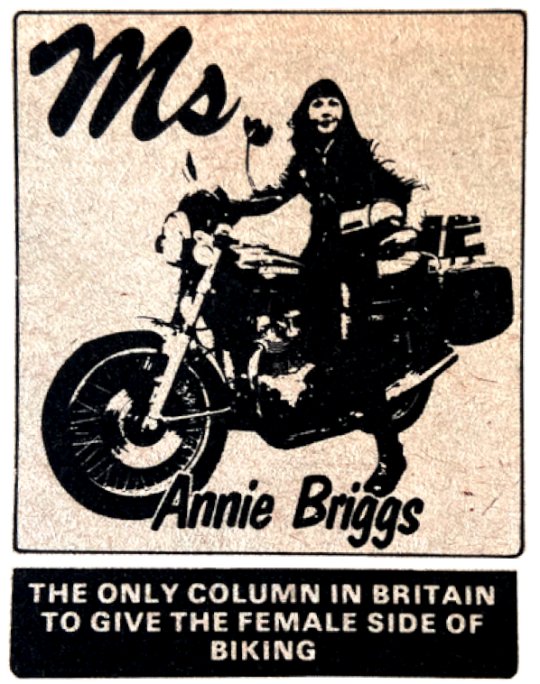
Annie Briggs was a sub editor and columnist on the staff of Motor Cycle Weekly. She was an active member of WIMA, a died-in-the-wool motor cyclist and a valued colleague.
This was . I don't have the original report to hand; all that remain are a few scraps of memory. It was cold but dry, we crossed the German border with some lads from Coventry, one of whom proceeded to goose-step up and down in front of bemused border guards. We were booked in at a gasthaus and I'd teased Annie that there might only be a single bedroom left. As we arrived the hausfrau apologised that there was only one room left so I passed an uncomfortable night on the floor. My only memory of the Elephant itself was that it didn't feel like the cosy rallies I was used too; it was too big, too crowded and simply overwhelming.
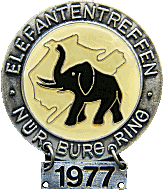
Having collected some quotes from Brits and filled a couple of 35mm films we would have turned in early. Those film canisters that had to be back at the office by early Sunday evening to be developed with film of other weekend events and the story had to be written up. Annie would have made sure we were on the road bright and early and all went well until we reached the Dutch border.
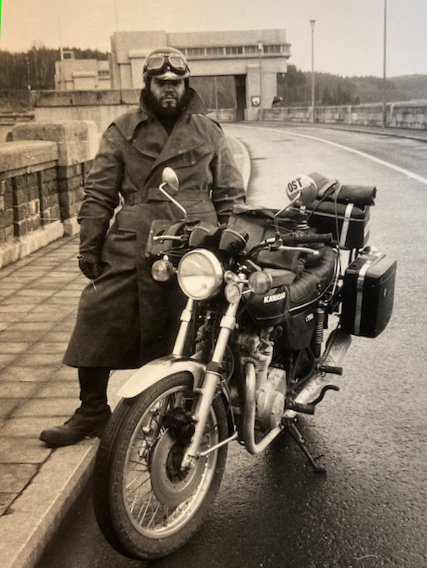
I don't have the pics Annie and I took at the 1977 Elephant Rally but do have this snapshot Annie took during a break on the road to the Nurburgring.
Now we get to the bit that I do remember. On the way out, thanks to Annie's experience of commuting to Germany on family visits she'd taken some relatively minor roads leading to an out-of-the-way crossing where laid back border guards wore grey-green uniforms and smiles. On the way back we pelted down the autobahn and the crossing was formidable. The uniforms were darker and the boots were highly polished. As Annie pulled up the guard stuck out his hand and simply said, "Papers!" Having been brought up on war films I had trouble keeping a straight face as we presented our passports. He scanned them, handed them back but instead of waving us off he added, "Bike papers!" Realising he wanted to see the Z750's logbook, and assuming, rightly, that Annie hadn't brought it with her, I butted in before Annie could answer (she spoke fluent German), played dumb and made out I didn't understand him. He waved over his superior (who in my memory had an even darker uniform, jackboots and probably a Luger). In perfect English this worthy explained, "My colleague wishes to see the motor cycle registration document."
Realising he was set to hold us at the border until the logbook could be faxed over, meaning we would miss our deadline and incur our boss's extreme displeasure, I panicked, put on a ridiculous cockney accent and pretended not to understand. It was all going pear shaped when three Dutchmen, presumably on their way home from the Nurburgring, thundered through without stopping (I seem to remember a rude gesture at the German guards) and disappeared into Dutch territory.
The guards were distracted; Annie sat quietly awaiting developments. I later apologised for thumping the back of her lid with my fist and screaming words to the effect of "I say, you amusingly distrait young lady, wouldn't it be a good idea if we took advantage of this serendipitous window of opportunity to make good our escape with all dispatch?" Annie took the hint, followed the Dutchmen and got us back to Dorset House, SE1 in good time.
I'd love to be able to recount tales of joining the torchlit parade, drinking a litre of Asbach and dossing in a snowdrift before riding home through a blizzard, but my abiding memory of my only Elephant Rally was leaning forward and bracing against the grab rail as Annie got us out of Germany.
My Treasure Chest - hover over to peek inside
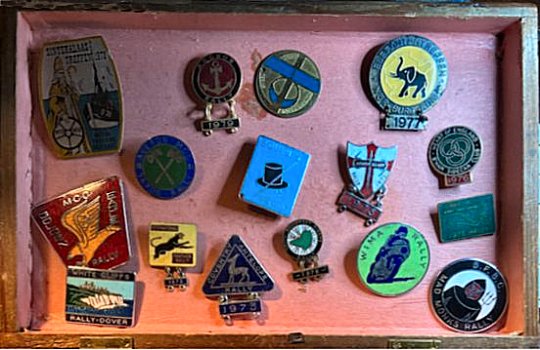
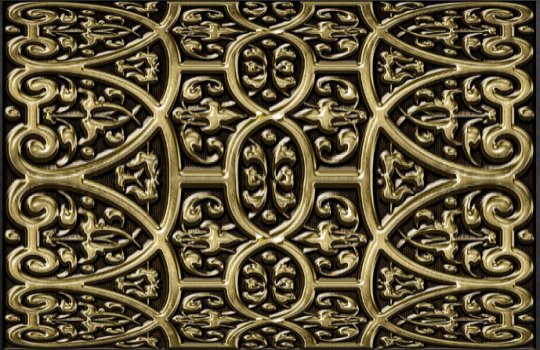
[Yes, in theory you should take your logbook when riding on the Continent; I've never done it and this was the only time it was requested. Some time later a German pal explained about 'Deutsches ordnung'. No doubt one sensible Brit had shown that border guard his logbook which triggered him to expect every Brit to do likewise.]
- Dave Richmond
35,000 people in attendance
Far too many under the influence of alcohol
Since I have a number of photos taken at the Elefantentreffen in 1977 in my archives, rather than leave them unused in the depths of my computer files, please allow me to share them below. They will make a perfect complement to the information about this rally provided recently by my good friend and esteemed colleague David Richmond.
A new breed of motorcyclist enters the scene
To set the scene for this particular 1977 meeting in the history of this rally, it is important to note that by the end of the 1970s, the face of the German motorcycling scene had changed considerably from that of the previous decade.
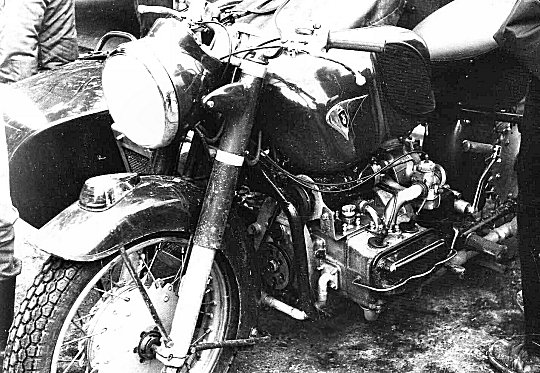
Elefant 1977 - Times had changed but, in the machine park, there were still some very interesting bitzas to be seen from all angles
German motorcycling at that time, at the dawn of the 80s, had given rise to a large number of outlaw and rebel clubs in all the country's towns and cities.
As a result, the old image of the Teutonic motorcyclist, still perceived by the public in the early 60s as either an original or someone who lacked the financial means to own a car, had now given way to a completely different kind of motorcyclist.
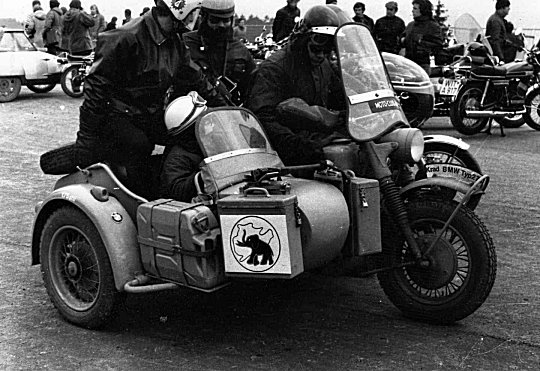
Elefant 1977 - Hundreds of combos, some well prepared for long-distance touring
The one with the more menacing appearance, riding a metal steed in chopper or customised American style, and dressed in his traditional one-percenter outfit, with the back patch revealing which club he represented. Few would have missed an event like Elefantentreffen 1977.
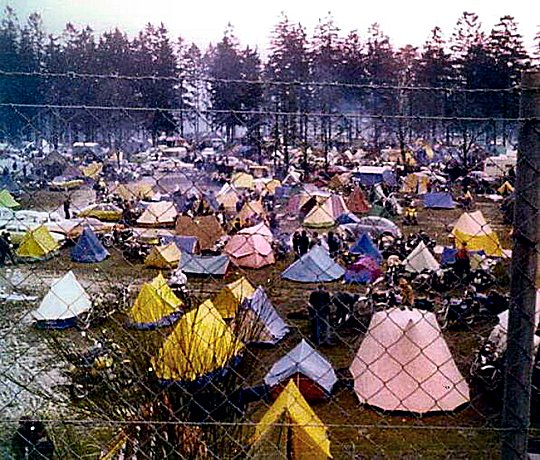
Elefant 1977 – View of one of the campsites around the circuit
And with the proximity of the Ruhr urban centres bringing even more visitors and participants to the legendary winter meeting over the years, in January 1977, the number of invaders in attendance all around the circuit was estimated at around 35,000.
If you would like to get a glimpse of the atmosphere at the meeting, here is an amateur film shot by a French motorcyclist who took part in the meeting that year:
Chaos and riots under the big top
At the main entrance to the circuit, there were a number of sales stands forming a sort of promenade line through the paddock, as well as a gigantic marquee erected for the occasion to provide food and drink.
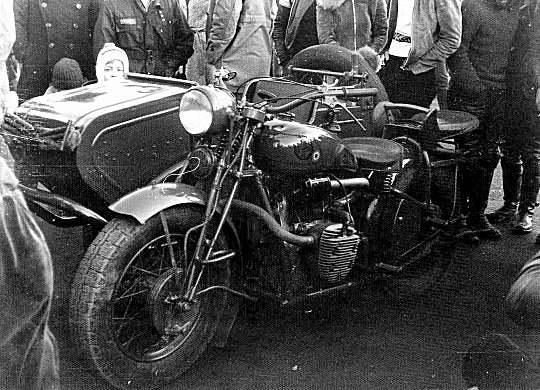
Elefant 1977 – The ideal event for the annual outing for 'old grannies' of yesteryear...
I've heard several more or less different versions of the riot that unfortunately occurred that Saturday night. This one below seems to me to be the most credible after checking and cross-checking several sources.
It was so cold on that Saturday evening that many of the participants had chosen to warm up with the simplest and most effective human anti-freeze: alcoholic drinks. While this is known to give excellent results, everyone knows that it does absolutely nothing to optimise the intelligence of those who consume more than is reasonable.
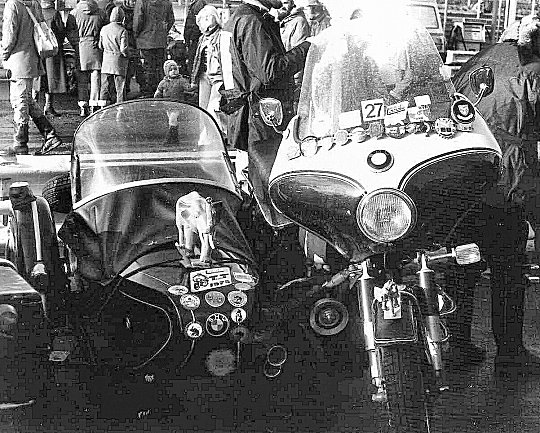
Elefant 1977 – Stickers and machine badges seen on this combo tell us that it previously drove its owner to the Tourist Trophy in the Isle of Man
Security had been entrusted to the well-known Bones MC. Everything was going well until a series of incidents sparked off a full-blown riot.
When fricadelles fly low
A small bunch of bikers who wanted drinks without having to pay for them jumped over the counter of a refreshment bar, turning it into an improvised free self-service outlet in a matter of seconds.
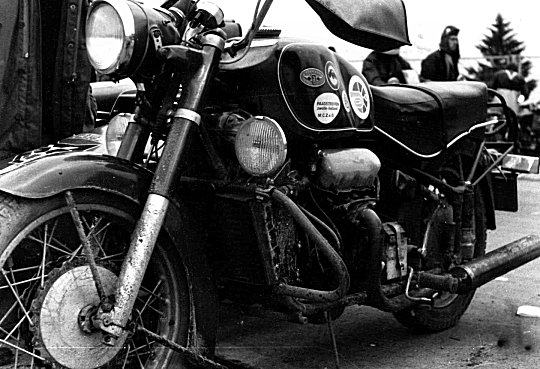
Elefant 1977 – Another bitza with a car engine, this time in a R51-3 frame. One of the stickers on the bottom of the tank is that of the Dutch rally team Paasei from the Z.E.O Holland club.
Almost immediately, others broke into a chip stall and stole around fifty fricandelles. Amid shouts, laughter and the strong smell of beer, some of the stolen fricandelles were used as projectiles, while running motorbikes made their way into the tent. Within minutes, chaos erupted under the hundred-metre-long big top, which the security force was unable to contain.
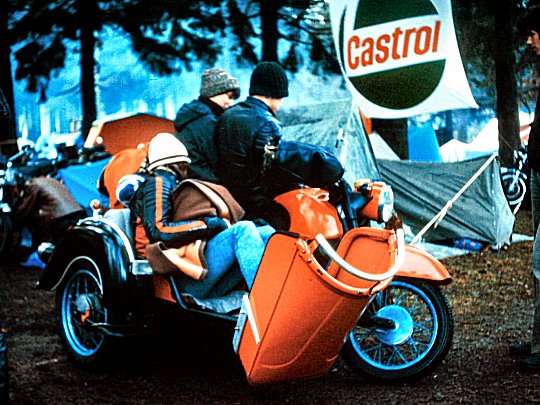
Elefant 1977 – Here's a very pretty representative of the brand from Zschopau, in Saxony, with its bright colours, visible and recognisable from afar amidst the greenery of the fir trees and the blue and orange colours of the camping tents.
Around a hundred police officers stationed nearby were called to intervene. It is said that in the melee, a rioter tried to take the service weapon from the holster of one of them. The police officer, feeling threatened, simply wanted to fire a warning shot into the air.
The tragic outcome was that the bullet hit the metal frame of the marquee, ricocheted and fell back into the crowd, fatally hitting one of the participants.
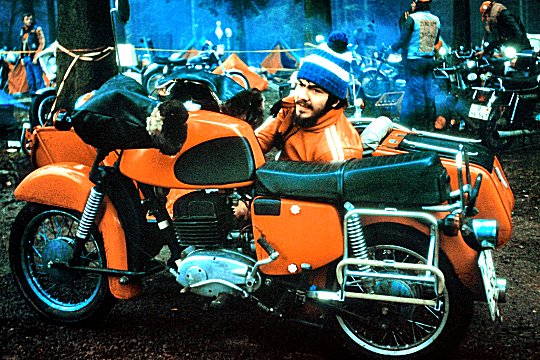
Elefant 1977 - Again the same East German combo, this time photographed from the other side and with its owner. A motorcyclist who seems particularly fond of the colour orange...
It was a surprising and sad fate for this unlucky man, who had come to have a good time and enjoy himself at the Elefantentreffen 1977, to die such a stupid death, bleeding to death on the soil of the Nurburging circuit...
With the death of this participant, it was likewise almost the death of the meeting forever. The German magazine Motorrad subsequently demanded in one of its issues that the meeting should be banned and never repeated.
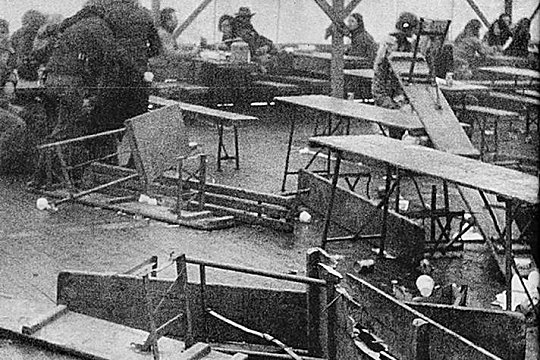
Elefant 1977 - Photo taken under the big top after the riot. The destroyed tables and benches bear witness to the chaos of that brutal Saturday night
For the following year, 1978, the meeting was moved to the Salzburgring, in Austria, far from any built-up area. The Salzburg authorities were, of course, aware of the German ban and did not give official permission for the meeting to take place.
But as the announcement had already appeared in the press, 400 bikers travelled to the Salzburgring in spite of everything. The BVDM organised a makeshift refreshment area to welcome them.
A documentary (in German) shows some excellent footage of this first edition in 1978 on the Salzburgring:
After observing what was happening in 1978, the Salzburg authorities decided to grant official authorisation for 1979.
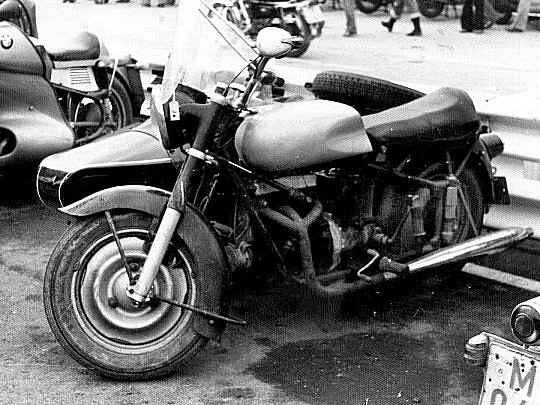
Elefant 1977 - A DIY creation among many other combos from this era
These new Austrian versions of the Elefantentreffen remained peaceful, and the event grew in popularity.
A new concept for the event was developed, which has proved its worth over the years without any notable incidents.
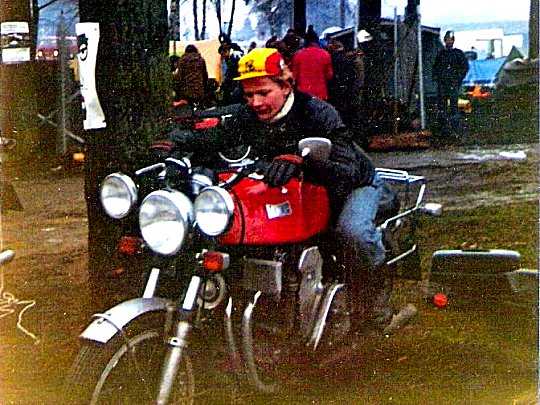
Elefant 1977 - Elephants and mammoths are two species that have certain things in common. It was therefore logical that they should be associated together on the Ring.
But for Ernst 'Klacks' Leverkus, the man behind the birth of the event, when he arrived at the Salzburgring in 1981 with his wife Inge in a sidecar, the old man said "it was so different from the spirit of the 60s".
His words reflected his disappointment that the scene was simply no longer his own. A generation had changed.
- Jean-Francois Helias